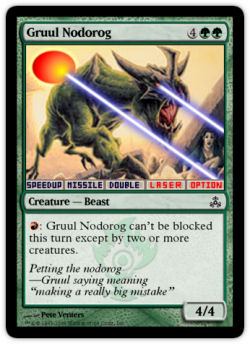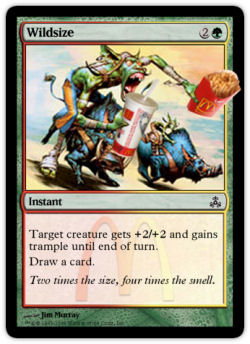Hello again!
This is part two of my Guildpact Limited review, you can read part one here.
Again, the rating system:
10: Bomb!
9: Excellent card
8: Great card
7: Good card (almost always play it)
6: Decent (feel free not to maindeck it, or side it out)
5: Fair
4: Only a deck-filler
3: Unplayable without crazy combos or circumstances
2: Just unplayable
1: …
On to the second Guild: G/R (Gruul)!
The Red cards are split into today’s article and tomorrow’s article as they belong in both the Gruul and the Izzet Guilds.
Battering Wurm
Battering Wurm is one of those creatures that you’ll only run when you really need a fatty: its function is much like Goliath Spider and Mindleech Mass. I’ve never had to run it yet but if you really have to, don’t be afraid.
4/10
Beastmaster’s Magemark
Another creature enchantment and it’s not good for the same reasons again. In general, creature enchantments aren’t good in Limited unless they either make a tremendous impact (example: Moldervine Cloak) or perform their main function when they enter play (example: Galvanic Arc), since they expose you to easy two-for-one trades.
3/10
Crash Landing
A Green mage’s troubles often lie in dealing with flying monsters, and Crash Landing is a reasonable spot removal to deal with a flyer. Its quality isn’t high at all, but cards generally get better when they are scarce.
7/10
Dryad Sophisticate
With seven non-basic lands in the common slots and seven more in the uncommon slots, all of which are playable, Dryad Sophisticate is more than just another two-mana guy and can be a pain for any deck in the format. I’d say that decks in this Limited format average close to two non-basic lands, often making the Dryad a dreaded monster.
8/10
Gatherer of Graces
Unless your deck is all good Auras, and contains very few early drops, Gatherer of Graces belongs in the sideboard.
3/10
Ghor-Clan Savage
If your deck is able to get a point of damage through early by making lots of tokens, having many early drops, having some flyers or spot removal, Ghor-Clan Savage can be gigantic as early as turn 5, or even turn 4. It’s not very hard to get in a point of damage by turn 4, and I’ve never failed to make this guy huge in the early game.
8/10
Gristleback
Comparable to Centaur Safeguard, Gristleback is a great defensive early drop. It doesn’t get shot by cards like Viashino Fangtail or Sparkmage Apprentice. The added bloodthirst ability makes it a good creature for more aggressive decks as well. This means that Gristleback is a good guy in any deck, and can function well no matter what role you’ve taken in the game, be it aggressive, defensive, or when the game is a damage race.
8/10

Gruul Nodorog
If you have a few power-ups to go with it, Gruul Nodorog can be very hard to deal with for your opponent. He can’t chump block it or trade creature-for-creature with it, so he’ll have to team his guys up, exposing them to an unfair situation.
7/10
Gruul Scrapper
There’s not much to be said about a 3/2 body for four mana that hopefully has haste. It’s a fine four-drop, but nothing to get excited about.
6/10
Predatory Focus
Somewhat different from Soulblast, but it usually functions the same way, and it’s about as good as that card used to be. It’s a great finisher for decks that need one, but you often have enough cards with that function already (examples: Overwhelm, Rally the Righteous, Incite Hysteria), so how highly you should pick it — or when you should cull it from the maindeck — depends entirely on the rest of your deck.
6/10 (on average, but it could range from 10/10 to 3/10, depending hugely on your deck)
Primeval Light
There are a few constraining enchantments that you’d want to destroy with this (example: Faith’s Fetters), but other than that there aren’t a lot of good targets for it. A decent sideboard card.
4/10
Silhana Ledgewalker
A 1/1 creature for two mana needs an outstanding ability to make it worthwhile, but Silhana Ledgewalker’s added effects don’t impress. If you have some cards that work well with it, like Moldervine Cloak or bloodthirsty creatures, you could run it — but only as a twenty-third card.
4/10
Silhana Starfletcher
It blocks flying creatures, fixes the color of your mana, and accelerates into your Green fatties. It’s got everything the Green mage could want to set up a sturdy game plan, for the knockdown price of three mana.
8/10
Skarrgan Pit-Skulk
It’s not really a one-drop, since it would just be a vanilla 1/1, but if you see it as a two- or three-drop it’s an overcosted 2/2 with an ability that’s barely significant.
2/10
Starved Rusalka
Another one-drop with a reasonable ability, but it’s just worse than Caregiver — a card that’s unexciting to begin with. As the Caregiver, Starved Rusalka can function as half a Llanowar Elves with another ability in a good Selesnya deck. It’s not that bad to have in the maindeck.
4/10

Wildsize
Combat tricks weren’t valued very highly in the triple-Ravnica format, but I’m sure Wildsize will be as it gives you pure card advantage. Wildsize replaces itself, allowing you to play it on more occasions than the usual combat trick as you can force through some extra damage (trample helps here against a chump-block) without losing a card.
8/10
Burning-Tree Bloodscale
I’ve always liked provoke-effects, as they force your opponent to leave different blockers back and therefore influence their game plan. Burning-Tree Bloodscale is no exception: even when you don’t get it as a 3/3, it messes with your opponent’s combat plan. If you have something to power it up it becomes more dangerous. It is expensive to use to the best of its ability, and that’s why I’ll only give it 7/10.
7/10
Feral Animist
It’s not so good in the early game, and I wouldn’t go as far as to say that it’s a late-game bomb, although when it’s combined with something that makes it hard to kill, like Galvanic Arc or Strands of Undead, it can be huge. If you have such enchantments or spot removal, the Alarmist can deal as much as eight — or even sixteen — damage in a single turn.
7/10
Savage Twister
Cheap mass removal. Uncommon. Yeah, this card seems perfectly fair. Nearly every form of mass removal has been huge in Limited, and Savage Twister is no exception.
10/10
Scab-Clan Mauler
I don’t think you should count Scab-Clan Mauler as a two-drop. To me, it’s a three- or four-drop that allows you to play a trick in the same turn. This makes it a good addition to any deck with a solid curve, making sure you’ll be able to get some points through early on. Off course, you could get lucky with it as well, and pump it out on turn 2.
7/10
Skarrgan Skybreaker
One of the better fatties that Green and Red have to offer, including Ravnica cards. It acts as a fatty, a finisher, or it gives you card advantage. By the time you have seven or eight mana available, you’re probably able to set up an attack that damages your opponent without having to make too many sacrifices, and Skarrgan Skybreaker dominates the game from there on.
8/10
Streetbreaker Wurm
The quintessential early fatty; it’s the best common five-drop Red and Green have in their arsenal.
8/10
Wreak Havoc
I would have liked Stone Rain a lot in the format, mostly because of the common Guild-dual-lands, but Wreak Havoc (or Caustic Rain) is just too expensive to make it worthwhile. Land destruction spells are usually a lousy late-game topdeck, unless your opponent has an uncommon Guild-land (Sunhome, Skargg) or artifact like Bottled Cloister or Sunforger. In those cases, board it in.
3/10
Gruul Guildmage
I dislike having a combat-shy early drop, steering clear of danger until you can abuse its abilities, but Gruul Guildmage can dominate creature combat, which is golden. Just like Ghost Warden, Skarrg or Kabuto Moth, it enables you to make unfair trades and nullifies many of your opponent’s cards.
9/10
Wild Cantor
Another 1/1 for one mana, but the ability is worse than many abilities of other one-drops. Sure, it can work out well when you curve into some fatty, but more often than not it’s a horrible draw.
3/10
Bloodscale Prowler
Its stats compare properly to its cost, but the low toughness makes it very easy for your opponent to trade for it. If you have a two-drop and some tricks and removal, its power becomes a lot scarier.
7/10
Ghor-Clan Bloodscale
In the early game it plays like a 2/1 unblockable beater, and after that it’s a reasonably big fatty with an upkeep. It’s a good four-drop, but nothing astonishing.
7/10
Rabble-Rouser
If you have many smaller creatures that get some damage in early on, Rabble-Rouser is quite a good finisher. Especially in Selesnya-decks it’s a great splash; in such decks you can easily make many tokens, get some damage in, and then rush into your opponent’s defense with 3/1 tokens. It’s not that good when your game plan is to accelerate into a fatty though, as it’ll only give one or two guys a bonus.
7/10
Scorched Rusalka
At first I thought it was really good but I’d misread it and thought it also hit creatures. The ability is still pretty good though, but the 1/1 body it’s attached to is not usually very meaningful in the mid-late-game.
6/10
Tin-Street Hooligan
This is another reasonable body for two mana, the catalyst of a relevant ability with so many Signets around to destroy. Don’t be reluctant to play it on turn 2 when you’re playing not first though, a Signet is usually the best possible turn 2 play for your opponent: if he had it, he would have played it. If you’re playing first, hold him back: you’re not sure if your opponent will present him with a target. As always, it depends on the circumstances.
7/10
Skarrg, the Rage Pits
Most of the uncommon Guild-lands are good enough to play, as long as it doesn’t hurt the mana base too much, but Skarrg can easily win you games by assisting immensely in creature combat to make unfair trades. In the early game, you often don’t even need to use your mana and activate it; just having it untapped and RG available can force your creatures through. It functions similar to a Kabuto Moth — while not as powerful — but it’s much harder to get rid of it, making it an excellent card.
9/10
That’s it for today. Come back tomorrow for the Izzet Guild and, later in the week, my analysis of the new Limited formats!

